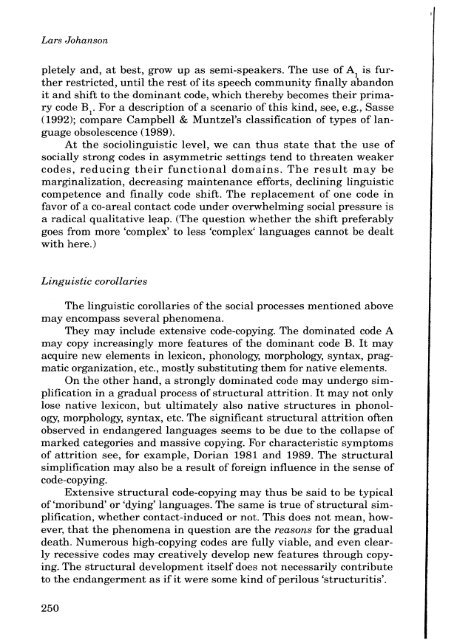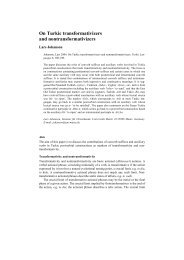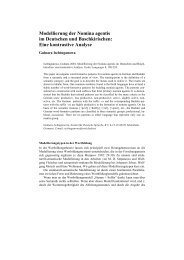Code-Copying - Turkic Languages
Code-Copying - Turkic Languages
Code-Copying - Turkic Languages
- No tags were found...
Create successful ePaper yourself
Turn your PDF publications into a flip-book with our unique Google optimized e-Paper software.
pletely and, at best, grow up as semi-speakers. The use of Al is further<br />
restricted, until the rest of its speech community finally abandon<br />
it and shift to the dominant code, which thereby becomes their primary<br />
code B . For a description of a scenario of this kind, See, e.g., Sasse<br />
(1992); compare Campbell & Muntzel's classification of types of language<br />
obsolescence (1989).<br />
At the sociolinguistic level, we can thus state that the use of<br />
socially strong codes in asymmetric settings tend to threaten weaker<br />
codes, reducing their functional domains. The result rnay be<br />
marginalization, decreasing maintenance efforts, declining linguistic<br />
competence and finally code shift. The replacement of one code in<br />
favor of a CO-areal contact code under overwhelming social pressure is<br />
a radical qualitative leap. (The question whether the shift preferably<br />
goes from more 'complex' to less 'complex' languages cannot be dealt<br />
with here.)<br />
The linguistic corollaries of the social processes mentioned above<br />
rnay encompass several phenomena.<br />
They rnay include extensive code-copying. The dominated code A<br />
may copy increasingly more features of the dominant code B. It rnay<br />
acquire new elements in lexicon, phonology, morphology, syntax, pragmatic<br />
organization, etc., mostly substituting them for native elements.<br />
On the other hand, a strongly dominated code rnay undergo simplification<br />
in a gradual process of structural attrition. It rnay not only<br />
lose native lexicon, but ultimately also native structures in phonology,<br />
morphology, syntax, etc. The significant structural attrition often<br />
observed in endangered languages seems to be due to the collapse of<br />
marked categories and massive copying. For characteristic symptoms<br />
of attrition See, for example, Dorian 1981 and 1989. The structural<br />
simplification rnay also be a result of foreign influence in the sense of<br />
code-copying.<br />
Extensive structural code-copying may thus be said to be typical<br />
of 'moribund' or 'dying' languages. The Same is true of structural simplification,<br />
whether contact-induced or not. This does not mean, however,<br />
that the phenomena in question are the reusons for the gradual<br />
death. Numerous high-copying codes are fully viable, and even clearly<br />
recessive codes rnay creatively develop new features through copying.<br />
The structural development itself does not necessarily contribute<br />
to the endangerment as if it were some kind of perilous 'structuritis'.




